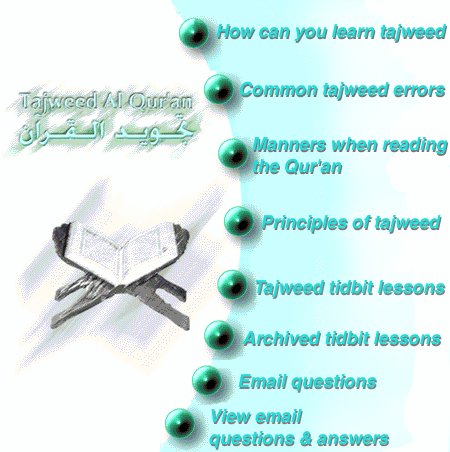|
|

copyright © 2002, abouttajweed.com, all rights reserved |
PRINCIPLES OF TAJWEED One
who wishes to learn a science needs to know its principles so that he will gain
insight into the sought science. There
are several principles in the science of tajweed that should be understood:
1.
Its
definition By linguistic definition: Betterment Applied definition: Articulating every
letter from its articulation point and giving the letter its rights and dues of
characteristics. Rights of the letters are its required
characteristics that never leave it. The
dues of the letters are its presented characteristics that are present in it some
of the time, and not present at other times.
i.e. the medd, idgham
2.
Its
formation The words of the Glorious Qur'an and some
said Honorable Hadiths also. 3. Its fruits It is preserving the tongue from mistakes
in pronunciation of the Glorious Qur’an during reading.
4.
Its
precedence It is one of the most honored of sciences
and one of the best of them due to its relation to Allah’s words.
5.
Its
place within the sciences It is one of the Islamic Law sciences that
are related to the Glorious Qur'an.
6.
Its
founder The rule setter from the practical point
of view is the Messenger of Allah
7.
Its
precept Knowledge of tajweed is fardh kifayaah,
meaning some of the Muslim community must know it, and its application is fardh
‘ain, required by all Muslims (men and women) who have the complete Qur’an
or part of it memorized, even if only one surah.
8.
Reasons
for its rules Guarding the Glorious Qur'an and
preserving it from distortion. The
Arabs mixed with non-Arabs after the spread of Islam, and the Muslims feared
that the Arab tongue would become corrupted with this intermixing.
It then became mandatory for rules to be put down that would preserve the
recitation of the Qur’an from mistakes, and guarantee the reader of the
Qur’an integrity of pronunciation.
9.
Its
principles The knowledge of tajweed is contingent on
four matters: 1. Knowledge of the articulation points of
the letters 2. Knowledge of the characteristics of the
letters 3. Knowledge of what rules change in the
letters due to the order of letters 4. Exercising the tongue and a lot of
repetition. |